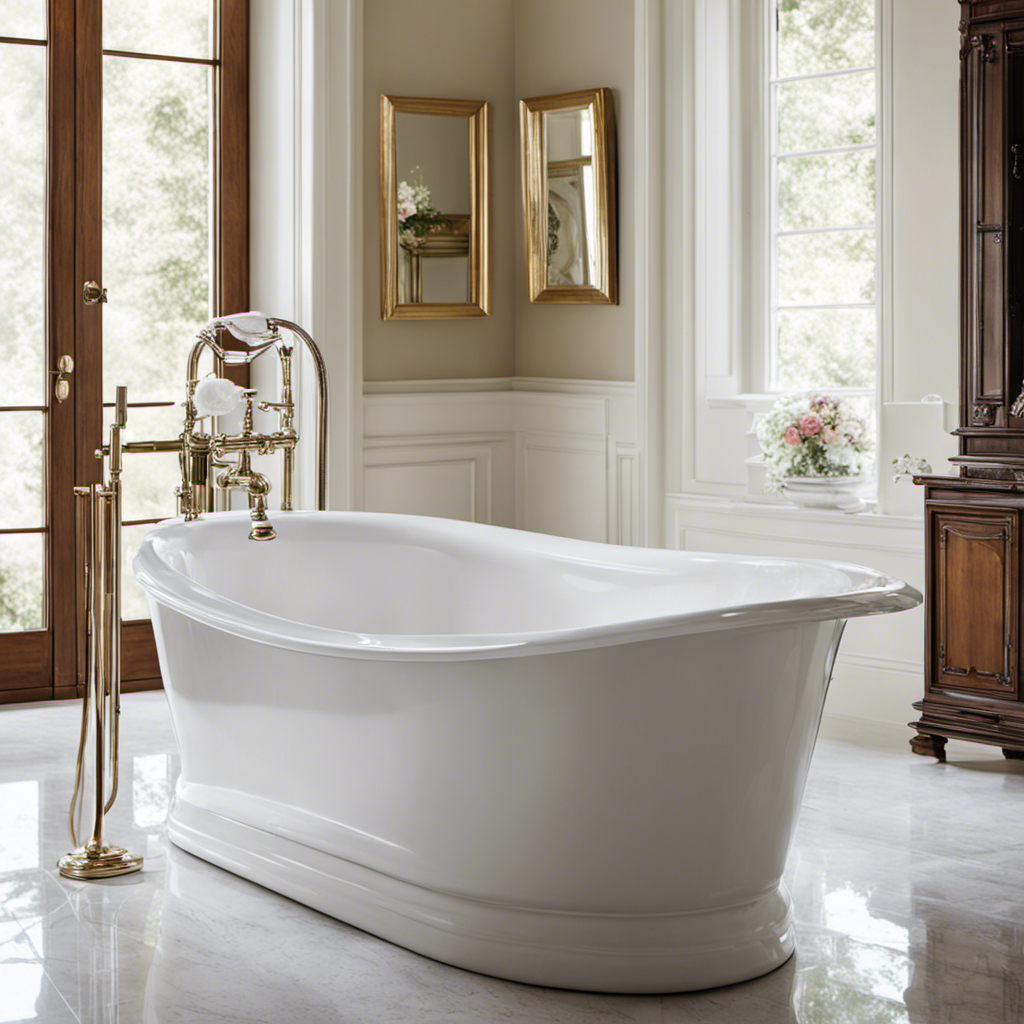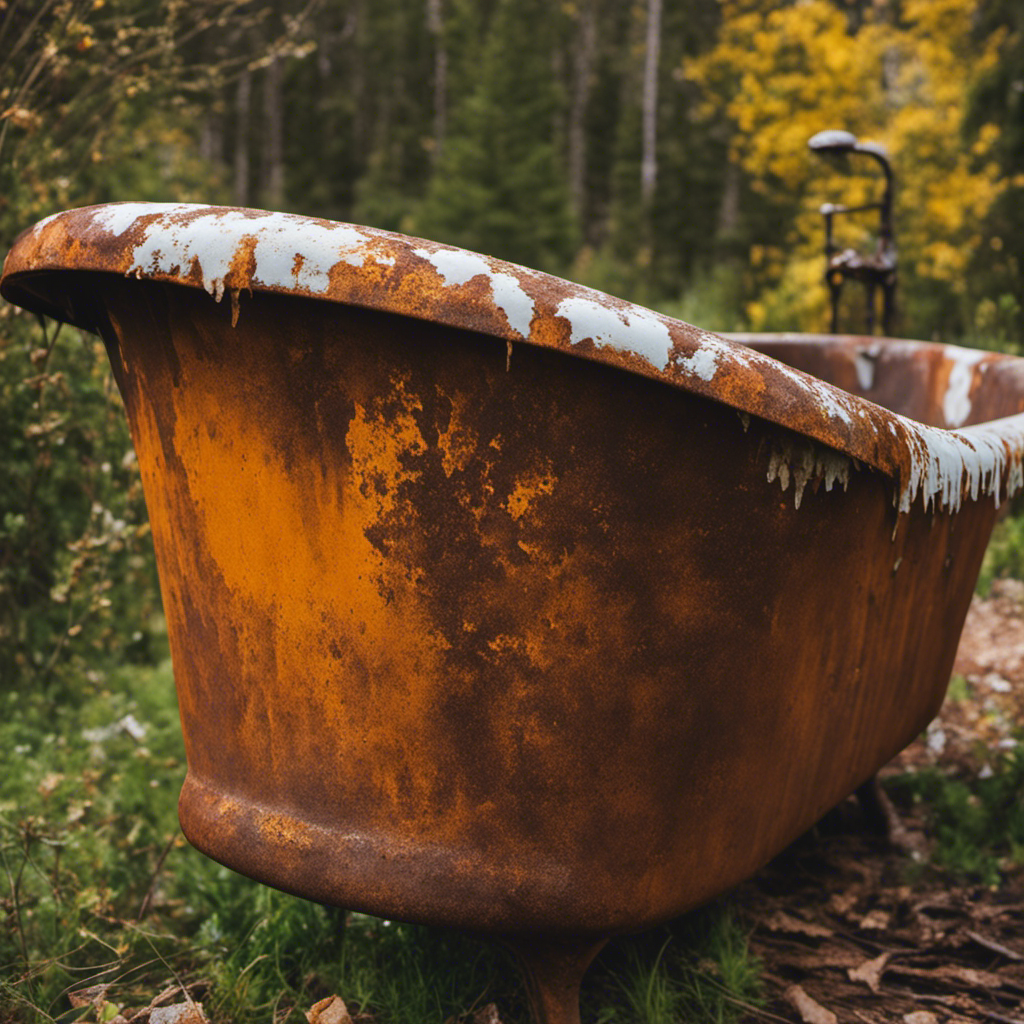I’ve got a secret to share with you about protecting your bathtub from water damage.
It all starts with choosing the right kind of caulk. But here’s the thing – not all caulk is created equal. In this article, I’ll reveal the best caulk for preventing water damage around your bathtub.
I’ll also walk you through the step-by-step process of applying it, and share some tips and tricks for maintaining it.
Get ready to say goodbye to leaks and hello to a pristine, watertight bathtub.
Key Takeaways
- Silicone caulk is waterproof, long-lasting, and highly resistant to water.
- Acrylic caulk is water-based, easy to apply, and paintable.
- Both silicone and acrylic caulk are resistant to mold and mildew.
- Proper removal of old caulk before applying new caulk is important.
Different Types of Caulk for Bathtub
You should consider using silicone caulk for your bathtub because it is waterproof and long-lasting.
Silicone caulk has many advantages when it comes to sealing around your bathtub. First, it is highly resistant to water, preventing any leaks or damage to the surrounding walls and floor. Additionally, silicone caulk is known for its durability, meaning it will last a long time without cracking or shrinking.
However, there are a few cons to consider as well. Silicone caulk can be more difficult to apply and requires proper ventilation due to its strong odor.
When it comes to alternative materials, there are options such as acrylic latex caulk or hybrid caulk. These alternatives have their own pros and cons, so it’s important to weigh them against silicone caulk before making a decision.
Taking into account the pros and cons of silicone caulk and considering alternative materials, it is essential to take various factors into account when choosing the right caulk for your bathtub.
Factors to Consider When Choosing Bathtub Caulk
One important factor to consider when choosing caulk for your bathtub is the durability of the product. You want a caulk that will withstand the constant exposure to water and moisture in the bathroom. Here are three key factors to consider when making your decision:
-
Importance of proper ventilation in the bathroom: Adequate ventilation is essential to prevent mold and mildew growth. Choose a caulk that is resistant to mold and mildew to ensure a clean and healthy environment.
-
How to remove old caulk from the bathtub: Before applying new caulk, it’s crucial to properly remove the old caulk. Use a caulk remover tool or a utility knife to carefully scrape away the old caulk. Clean the surface thoroughly to ensure proper adhesion of the new caulk.
-
Compatibility with different surfaces: Make sure the caulk you choose is suitable for the type of material your bathtub is made of. Whether it’s porcelain, fiberglass, or acrylic, select a caulk that is specifically designed for that surface.
With these factors in mind, you can now move on to finding the best caulk for preventing water damage around your bathtub.
The Best Caulk for Preventing Water Damage Around Bathtub
When looking for the best caulk to prevent water damage around your bathtub, it’s essential to consider its resistance to mold and mildew. Regular caulk maintenance is of utmost importance for the longevity of your bathtub.
Two popular options for bathtub caulk are acrylic and silicone. Acrylic caulk is water-based and easy to apply. It is also paintable, making it a versatile choice. However, it is not as durable as silicone caulk and may require more frequent maintenance.
On the other hand, silicone caulk is highly resistant to water and mold, making it perfect for areas prone to moisture. It is also more flexible, allowing for movement without cracking.
Ultimately, the choice between acrylic and silicone caulk depends on your specific needs and preferences. Regular maintenance is key to preventing water damage and ensuring the long-term durability of your bathtub.
Step-by-Step Guide: How to Apply Caulk Around Bathtub
To apply caulk around the bathtub, start by cleaning the surface thoroughly with a mild detergent and water mixture. This step is crucial because it ensures that the caulk adheres properly and creates a watertight seal.
After cleaning, follow these steps:
-
Choose the right caulk: It is important to select a caulk that is specifically designed for bathroom use. Look for one that is mold and mildew resistant to prevent any future issues.
-
Prep the area: Remove any old caulk and make sure the surface is dry before applying the new caulk. Use a caulk gun for precise application.
-
Apply the caulk: Start at one corner and apply a smooth and even bead of caulk along the joint between the bathtub and the surrounding tiles or wall. Use a caulk smoothing tool or your finger to smooth out the caulk and remove any excess.
Proper caulk application is essential in bathroom renovation projects to prevent water damage and maintain the integrity of the bathtub area. Avoid common mistakes such as applying too much caulk, not smoothing it out properly, or using the wrong type of caulk.
Tips and Tricks for Maintaining Caulk Around Bathtub
Maintaining caulk around the bathtub is important for preventing water damage and ensuring a long-lasting seal. To help you with this task, here are some tips and tricks for maintaining caulk around your bathtub. First, let’s talk about common mistakes to avoid when caulking. One mistake is not properly cleaning and removing old caulk before applying new caulk. This can lead to poor adhesion and a shorter lifespan. To remove old caulk, you can use a caulk remover tool or a utility knife. Be sure to thoroughly clean the area before reapplying new caulk. Another mistake is not using the right caulk for your bathtub. Make sure to choose a caulk that is specifically designed for use in wet environments. Now, let’s take a look at a table that summarizes these tips:
| Common Mistakes to Avoid | How to Remove Old Caulk |
|---|---|
| Not cleaning the area properly before applying new caulk | Use a caulk remover tool or utility knife |
| Using the wrong caulk for your bathtub | Choose a caulk designed for wet environments |
Conclusion
In conclusion, choosing the right caulk for your bathtub is crucial in preventing water damage and maintaining a clean and safe environment.
By considering factors such as flexibility, durability, and mold resistance, you can find the perfect caulk that suits your needs.
Just like a strong adhesive holding things together, the right caulk acts as a protective barrier, sealing any gaps or cracks around your bathtub.
So, don’t overlook the importance of using the right caulk – it’s like finding the perfect puzzle piece to complete the picture of a watertight bathtub.










